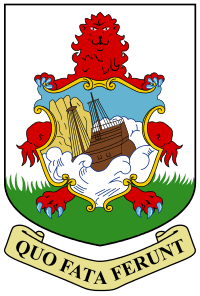Coat of arms of Bermuda

The coat of arms of Bermuda depicts a red lion holding a shield that has a depiction of a wrecked ship upon it. The red lion is a symbol of England and alludes to Bermuda’s relationship with that country. The wrecked ship is that of a French ship under the command of Captain M. de la Barbotiere, not the Sea Venture, the flagship of the Virginia Company. In 1593 November 30, Captain de la Barbotiere sailed from Laguna, Hispaniola, and on December 17 of that same year, at midnight the ship struck the north-west reefs off of Bermuda and were so badly damaged that out of fifty five men, only twenty six reached the shore alive. Henry May and Captain de la Barbotiere were among the survivors. It is the wreck of this French ship on the Bermuda coat of arms. The crew cut down Bermuda cedar trees and built a seaworthy craft of eighteen tons. They caulked her seams with lime salvaged from the ship and oil extracted from local turtles they caught for food. They ate turtle meat, fish, birds - and wild hogs.
It is widely believed that the wrecked ship on the Coat of Arms is that of the Sea Venture, the flagship of the Virginia Company, but it is not. This ship was deliberately driven on to the reefs of Bermuda, by Admiral Sir George Somers, in 1609, to prevent it from foundering in a storm. All aboard survived, resulting in the settlement of the island. The Latin motto under the coat of arms, Quo Fata Ferunt, means “Whither the Fates Carry [Us]”.
In the twentieth century, the coat of arms—without the banner holding the motto—was added to the Red ensign to create the distinguishing colonial flag (the national flag is the Union Jack, which appears in its upper, left corner), and on the Governor's Flag. The coat of arms features on the cover of the 1624 edition of The Generall Historie of Virginia, New-England, and the Summer Isles (the Somers Isles is another name for Bermuda, commemorating Admiral Somers), by Captain John Smith.
The coat of arms replaced a badge which had been in use before 1910. The badge was based on a sketch, made in 1869, of the 1817 seal, which depicted a wet dock of the time showing with some boats in the background. It is assumed that the scene alludes to the fact that the islands were a stopover base for the sailing ships[1] when the badge was approved by the Admiralty.
The heraldic blazon is: Argent, on a mount vert a lion sejant affronté gules supporting between the fore-paws an antique shield azure thereon a representation of the wreck of the ship Sea Venture proper.